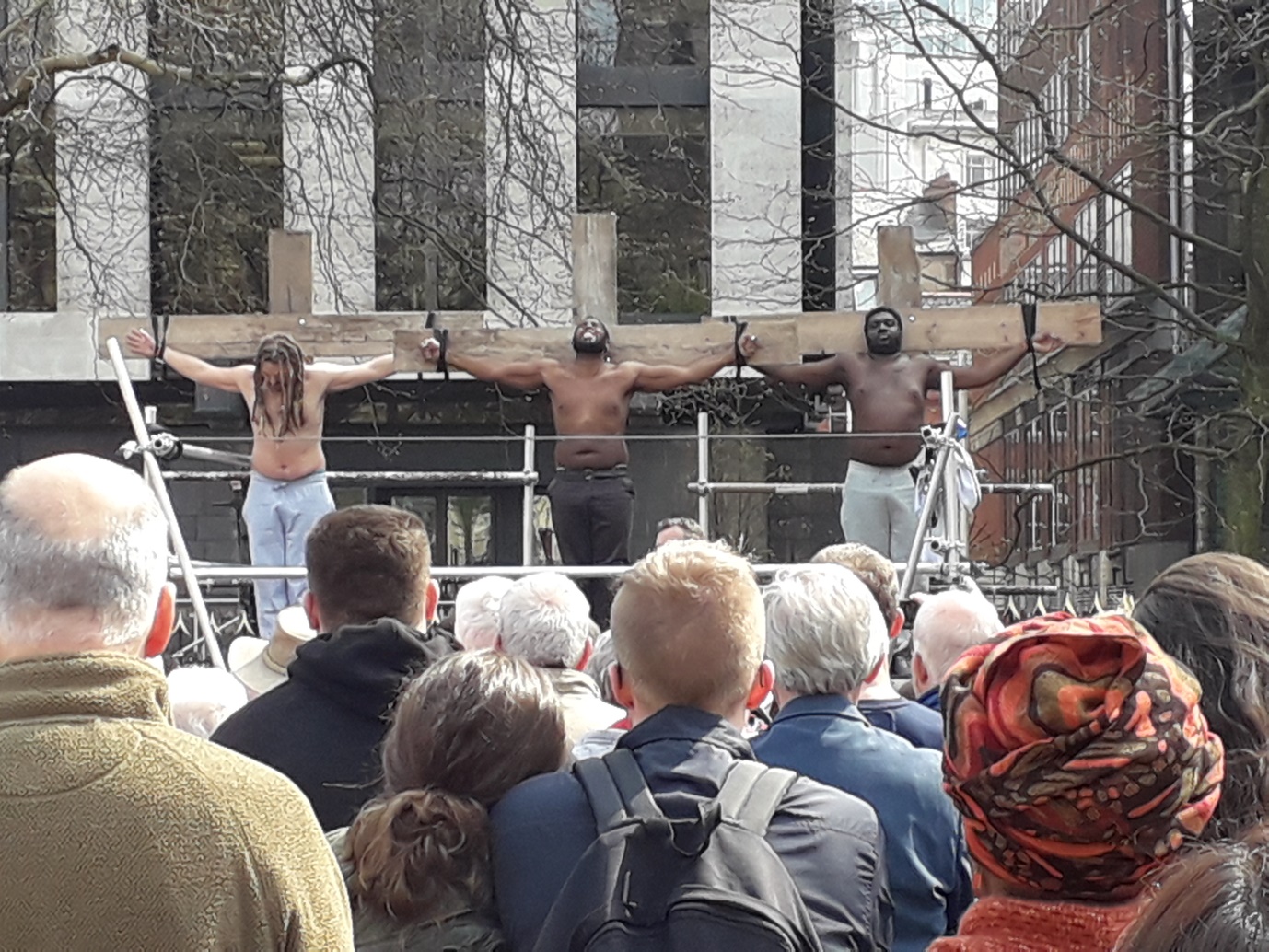19 Apr. Jesus is executed by crucifixion
"The [Roman] governor's soldiers took Jesus into the governor's palace, and they all gathered around him. They took off his clothes and put a red robe on him. Using thorny branches, they made a crown, put it on his head, and put a stick in his right hand. Then the soldiers bowed before Jesus and made fun of him, saying, 'Hail, King of the Jews!’"
"They spat on Jesus. Then they took his stick and began to beat him on the head. After they finished, the soldiers took off the robe and put his own clothes on him again. Then they led him away to be crucified."
"As the soldiers were going out of the city with Jesus, they forced a man from Cyrene, named Simon, to carry the cross for Jesus. They all came to the place called Golgotha, which means the Place of the Skull. The soldiers gave Jesus wine mixed with gall to drink [as a painkiller]. He tasted the wine, but refused to drink it."
"When the soldiers had crucified him, they threw lots to decide who would get his clothes... They put a sign above Jesus's head with a charge against him. It said: THIS IS JESUS, THE KING OF THE JEWS."
"Two robbers were crucified beside Jesus, one on the right and the other on the left. People walked by and insulted Jesus and shook their heads, saying, 'You said you could destroy the Temple and build it again in three days. So save yourself! Come down from that cross if you are really the Son of God!'"
(Matthew 27:27-40)

After Pilate gave in to the pressure exerted by the Jewish chief priests, he handed Jesus over to his soldiers to be executed. The Roman soldiers took him inside the governor’s residence, where they mocked Jesus as the "King of the Jews" and dressed him in a scarlet robe (a symbol of Roman imperial power) and a crown made of thorns.
Simon from Cyrene (who was probably a devout Jew visiting Jerusalem for the Passover festival) was forced to help carry Jesus’s cross to the place of crucifixion, outside the city walls. Cyrene was a port in Cyrenaica (modern-day Libya), rich in wheat, wool and dates. It had a Jewish settlement and had become a Roman province in 74BC.
Shortly after 8.00am (during the ‘third hour’) Jesus was crucified at 'Golgotha' (an Aramaic word meaning ‘Place of the skull’) on the hill of 'Calvary' (a Latin word, also meaning ‘Place of the skull’), just outside the walls of Jerusalem (see 7 on the map on 10 April).
That Friday – 7th April 30AD – is now commemorated each year by Christians as ‘Good Friday’ - the day when Jesus died as the ultimate sacrifice, rendering the system of sacrifices in the Temple redundant, and making faith in Jesus as God’s ‘anointed one’ the only way to be put right with God.
When Jesus reached Golgotha, the place of his crucifixion, the Roman soldiers nailed a written charge on the cross above Jesus’s head (a ‘titulus’ or ‘title’). It read, "Jesus of Nazareth, the King of the Jews" in Aramaic (the local language that Jesus spoke), in Latin (the official language of the Roman Empire) and in Greek (the universally spoken language of the eastern Mediterranean world).
The letters ‘I.N.R.I.’ – often seen on western medieval paintings of the crucifixion – stand for the words of the Latin inscription ‘Iesus Nazarenus, Rex Iudaeorum’ – ‘Jesus of Nazareth, King of Judaea’ (the land of the Jews). In Greek and other Orthodox churches, icons often bear the letters ‘I.N.B.I’ representing the words of the Greek translation (the ‘B’ stands for ‘Basileos’ – ‘King’).
Two robbers were crucified beside Jesus, one on his right and one on his left. The Roman soldiers gambled by casting lots to divide up Jesus’s clothing (see Psalm 22:18), while passers-by hurled insults at Jesus and told him to save himself “if you are really the Son of God” (Matthew 27:40) (see Psalm 22:7-8).
Matthew's account (in Matthew 27:45-56) tells us that from the ‘sixth hour’ (beginning just before 11.00am) until the ‘ninth hour’ (starting a few minutes after 2.00 pm), dark storm clouds covered the land.
Shortly after two in the afternoon, Jesus called out, “My God, my God, why have you abandoned me?” (Matthew 27:46), quoting the very psalm, written by King David, that others had just hurled at him in abuse (see Psalm 22:1).
Some thought he was calling Elijah – who was believed to help the godly in times of need and was expected to re-appear when the Messiah or Christ came to earth (see Malachi 4:5).
Finally, Jesus cried out again in a loud voice, then gave up his spirit and died. At that moment, there was a huge earthquake and the curtain of the Temple – separating The Most Holy Place (the symbolic dwelling place of God) from God’s people – was torn in two.
From now on, believers would be able to 'go through the curtain' and enter directly into God’s presence, because Jesus – by shedding his blood and dying on the cross – 'paid the price' of mankind’s rejection of God and put those who believe in him right with God (see Hebrews 9:1-14 & 10:19-22).
The photo shows the crucifixion scene in the Birmingham (UK) Passion Play on 17th April 2019.
You can discover more about the meaning of the events that occurred during Holy Week in 30AD @ https://www.thebiblejourney.org/…/6-jesuss-last-journey-to…/
